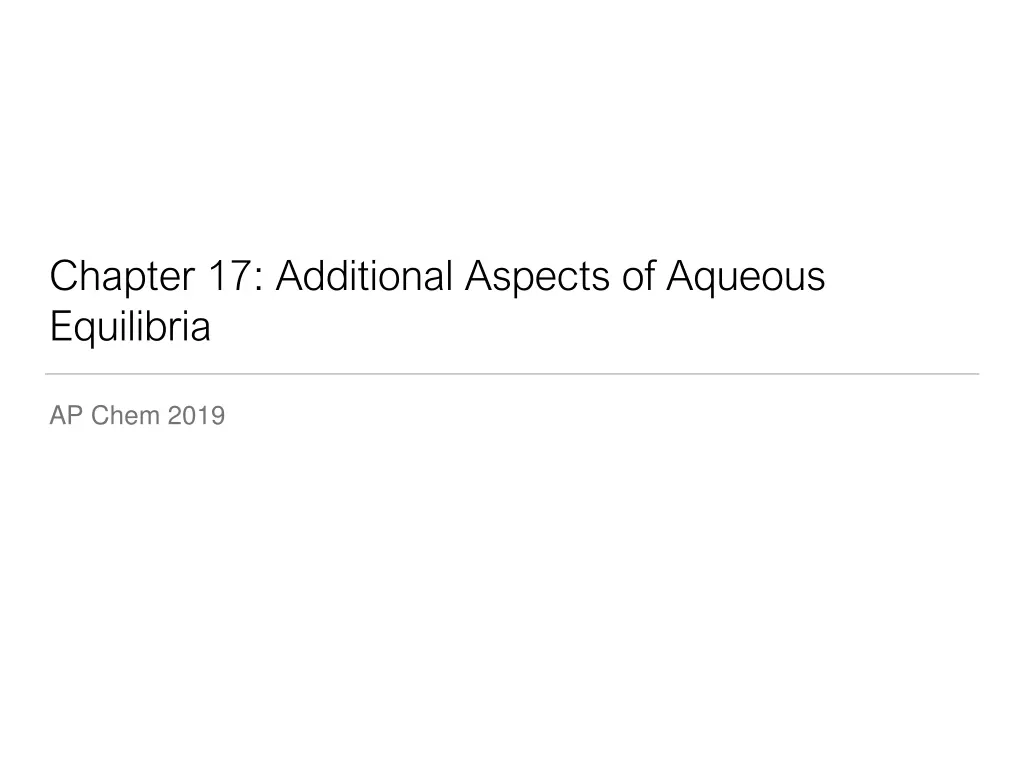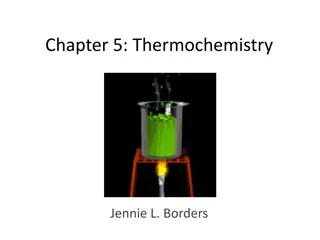
Aqueous Equilibria: Explore Aspects and Applications in Chemistry
Dive into Chapter 17 of AP Chemistry 2019 covering additional aspects of aqueous equilibria. Topics include the common ion effect, buffers, titrations, solubility equilibria, precipitation, and separation of ions. Understand concepts such as how buffers resist pH changes and the common ion effect's impact on weak electrolytes. Access problem sets and examples to enhance your learning experience.
Download Presentation

Please find below an Image/Link to download the presentation.
The content on the website is provided AS IS for your information and personal use only. It may not be sold, licensed, or shared on other websites without obtaining consent from the author. If you encounter any issues during the download, it is possible that the publisher has removed the file from their server.
You are allowed to download the files provided on this website for personal or commercial use, subject to the condition that they are used lawfully. All files are the property of their respective owners.
The content on the website is provided AS IS for your information and personal use only. It may not be sold, licensed, or shared on other websites without obtaining consent from the author.
E N D
Presentation Transcript
Chapter 17: Additional Aspects of Aqueous Equilibria AP Chem 2019
Chapter 17 Topics 17.1 Common Ion Effect 17.2 Buffers 17.3 Titrations! 17.4 Solubility Equilibria 17.5 Factors of Solubility 17.6 Precipitation and Separation of Ions
17.1 Common Ion Effect Common ion effect - extent of ionization of a weak electrolyte is decreased by adding to the solution a strong electrolyte that has an ion in common with the weak electrolyte Example: Combination of acetic acid (weak electrolyte) and sodium acetate (strong electrolyte) What determines the strength ?
17.1 Common Ion Effect If we combine these two solutions We are increasing acetate ion in solution causes the equilibrium to shift left by consuming H+
17.1 Common Ion Effect Example Example 17.1: 0.3 mol NaC2H3O2 and 0.3 mol HC2H3O2 are combined in enough water to make 1.0 L. What is the pH?
17.2 Buffered Solutions Buffers - resist drastic changes in pH upon the addition of small amounts of strong acids or bases Applications Calibration of pH meters (depends on range) Blood (bicarbonate buffer) Seawater (bicarbonate buffer) Custom media
17.2 Buffered Solutions How do buffers work? Buffers contain both basic and acidic species Acidic species can neutralize OH- Basic species can neutralize H+ Typically formed by a weak-acid base conjugate pair such as HC2H3O3 and C2H3O2- NH4+ and NH3 They also must not neutralize each other, so typically a weak acid is combined with a salt of that acid
17.2 Buffered Solutions Determining how a buffer works: Dissociation equation HX (aq) < > H+ (aq) + X- (aq) Eq. expression Ka = [H+][X-]/[HX] Solving for [H+] [H+] = Ka*[HX]/[X-]
17.2 Buffered Solutions Based on the dissociation equation . HX (aq) < > H+ (aq) + X- (aq) Adding OH- decreases H+, increasing X- in solution Adding H+ decreases X-, increasing H+ in solution The ability to resist change in pH is dependent on the amount of HX and X- in solution
17.2 Buffered Solutions HF (aq) < > H+ (aq) + F- (aq)
17.2 Buffered Solution: Calculating pH of buffers Conjugate acid - base pairs share a common ion Therefore we can use the same technique we used in common ion effect but Henderson Hasselbach equation is more commonly used Derived from [H+] = Ka*[HX]/[X-] Determining the pH of a buffer allows a scientist to design buffers in specific ranges
17.2 Buffered Solutions: Deriving Henderson Hasselbach [H+] = Ka*[HX]/[X-] (neg. log both sides) -log[H+] = -logKa - log[acid]/[base] (log rules) pH = pKa + log [c.base]/[acid] pH = pKa + log [c.base]/[acid] when c. base = acid pH = pKa
17.2 Buffered Solutions Ex. 1 What is the pH of a buffer that is 0.12 M in lactic acid and 0.10 M in sodium lactate? Ka = 1.4 x 10 ^ -4
17.2 Buffering Capacity Buffering Capacity - amount of acid or base the buffer can neutralize before the pH changes drastically More concentrated solutions, 1 M vs 0.1 M of weak acids and their conjugate bases have differing capacity More concentrated buffers have the capacity to neutralize more effectively The pH they can buffer depends on the Ka or Kb






















